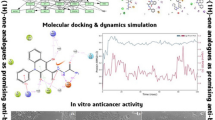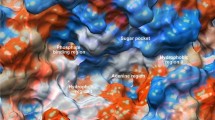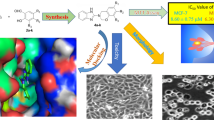Abstract
6,8-Dibromo-2-(4-chlorophenyl)-quinazolin-4-one linked directly to oxadiazole 5, pyrazole 6 or through amide linkage to thiazolidinone 2a–d and 3a–h were synthesized; their chemical structures were confirmed by spectral and elemental analyses. Their anti-breast cancer activity was evaluated against human breast cancer cell line (MCF-7) using resazurin reduction method and doxorubicin as a reference drug. Linking quinazolin-4-one scaffold to oxadiazole or pyrazole gave compounds 5 and 6 with a closely similar activity as doxorubicin; their IC50 was 23, 22 and 22 nmol/ml, respectively; however, the hybridization of quinazolin-4-one with thiazolidinone gave much better activity than doxorubicin. The most active compounds of the hybrid molecules between quinazolin-4-one and thiazolidinone are 2c,d and 3a,f. Their IC50 range was (3–9 nmol/ml). In an attempt to explore the mode of action of the best active compounds, docking on the ATP binding site of EGFR was performed. In vitro screening of these four compounds against EGFR tyrosine kinases showed inhibitory activity range 54–77.2 %.








Similar content being viewed by others
References
Ahmed MF, Youns M, Belal A (2016) Design, synthesis, molecular docking and anti-breast cancer activity of novel quinazolinones targeting ERα. Acta Pol Pharm 73(1)
Alagarsamy V, Solomon VR, Sheorey RV, Jayakumar R (2009) 3-(3-Ethylphenyl)-2-substituted hydrazino-3H-quinazolin-4-one derivatives: new class of analgesic and anti-inflammatory agents. Chem Biol Drug Des 73:471–479
Al-Omary FAM, Hassan GS, El-Messery SM, Nagi MN, Habib ESE, El-Subbagh HI (2013) Nonclassical antifolates, part 3: synthesis, biological evaluation and molecular modeling study of some new 2-heteroarylthio-quinazolin-4-ones. Eur J Med Chem 63:33–45
Al-Suwaidan IA, Alanazi AM, Abdel-Aziz AA-M, Mohamed MA, El-Azab AS (2013) Design, synthesis and biological evaluation of 2-mercapto-3-phenethylquinazoline bearing anilide fragments as potential antitumor agents: molecular docking study. Bioorg Med Chem Lett 23:3935–3941
Barlesi F, Tchouhadjian C, Doddoli C, Villani P, Greillier L, Kleisbauer J-P, Thomas P, Astoul P (2005) Gefitinib (ZD1839, Iressa) in non-small-cell lung cancer: a review of clinical trials from a daily practice perspective. Fundam Clin Pharmacol 19:385
Burris HA, Hurwitz HI, Dees EC, Dowlati A, Blackwell KL, O’Neil B, Marcom PK, Ellis MJ, Overmoyer B, Jones SF, Harris JL, Smith DA, Koch KM, Stead A, Mangum S, Spector NL (2005) Phase I safety, pharmacokinetics, and clinical activity study of lapatinib (GW572016), a reversible dual inhibitor of epidermal growth factor receptor tyrosine kinases, in heavily pretreated patients with metastatic carcinomas. J Clin Oncol 23:5305–5313
Chandrika PM, Yakaiah T, Rao ARR, Narsaiah B, Reddy NC, Sridhar V, Rao JV (2008) Synthesis of novel 4,6-disubstituted quinazoline derivatives, their anti-inflammatory and anti-cancer activity (cytotoxic) against U937 leukemia cell lines. Eur J Med Chem 43:846–852
Decker M (2005) Novel inhibitors of acetyl- and butyryl cholinesterase derived from the alkaloids dehydroevodiamine and rutaecarpine. Eur J Med Chem 40:305–313
Dongamanti A, Gadiparthi R, Redamala R, Anireddy J, Burri N, Vantikommu J (2012) Synthesis, anti-bacterial, anti-asthmatic and anti-diabetic activities of novel 3-substituted quinazolin-4-ones using 1-butyl-3-methyl-imidazoliumtetrafluoro borate [BMIM+][BF4−] as a green, efficient and reusable catalyst under solvent free conditions. J Chem Pharm Res 4(8):3991–4000
Galal SA, Abdelsamie AS, Rodriguez ML, Kerwin SM, El Diwani HI (2010) Synthesis and studying the antitumor activity of novel 5-(2-methyl benzimidazol-5-yl)-1,3,4-oxadiazole-2(3H)-thiones. Eur J Chem 1(2):67–72
Georgey H, Abdel-Gawad N, Abbas S (2008) Synthesis and anticonvulsant activity of some quinazolin-4-(3H)-one derivatives. Molecules 13:2557–2569
Havrylyuk D, Mosula L, Zimenkovsky B, Vasylenko O, Gzella A, Lesyk R (2010) Synthesis and anticancer activity evaluation of 4-thiazolidinones containing benzothiazole moiety. Eur J Med Chem 45:5012–5021
Hennequin LF, Stokes ESE, Thomas AP, Johnstone C, Plé PA, Ogilvie DJ, Dukes M, Wedge SR, Kendrew J, Curwen JO (2002) Novel 4-anilinoquinazolines with C-7 basic side chains: design and structure activity relationship of a series of potent, orally active, VEGF receptor tyrosine kinase inhibitors. J Med Chem 45:1300
Ismail MAH, Barker S, Abau El Ella DA, Abouzid KAM, Toubar RA, Todd MH (2006) Design and synthesis of new tetrazolyl- and carboxy-biphenylylmethyl-quinazolin-4-one derivatives as angiotensin II AT1 receptor antagonists. Med Chem 49:1526–1535
Kopper L (2008) Lapatinib: a sword with two edges. Pathol Oncol Res 14:1–8
Lv P-C, Li H-Q, Sun J, Zhou Y, Zhu H-L (2010) Synthesis and biological evaluation of pyrazole derivatives containing thiourea skeleton as anticancer agents. Bioorg Med Chem 18:4606–4614
Ma H, Deacon S, Horiuchi K (2008) The challenge of selecting protein kinase assays for lead discovery optimization. Expert Opin Drug Discov 3:607–621
Mohamed MS, Kamel MM, Kassem EMM, Abotaleb N, Abd El-moez SI, Ahmed MF (2010) Novel 6,8-dibromo-4(3H)quinazolinone derivatives of anti-bacterial and anti-fungal activities. Eur J Med Chem 45:3311–3319
Olayioye MA, Neve RM, Lane HA, Hynes NE (2000) The ErbB signaling network: receptor heterodimerization in development and cancer. EMBO J 19:3159–3167
Pollack VA, Savage DM, Baker DA, Tsaparikos KE, Sloan DE, Moyer JD, Barbacci EG, Pustilnik LR, Smolarek TA, Davis JA, Vaidya MP, Arnold LD, Doty JL, Iwata KK, Morin MJ (1999) Inhibition of epidermal growth factor receptor-associated tyrosine phosphorylation in human carcinomas with CP-358,774: dynamics of receptor inhibition in situ and antitumor effects in athymic mice. J Pharmacol Exp Ther 291:739–748
Rusnak DW, Lackey K, Affleck K, Wood ER, Alligood KJ, Rhodes N, Keith BR, Murray DM, Knight WB, Mullin RJ, Gilmer TM (2001) The effects of the novel, reversible epidermal growth factor receptor/ErbB-2 tyrosine kinase inhibitor, GW2016, on the growth of human normal and tumor-derived cell lines in vitro and in vivo. Mol Cancer Ther 1:85–94
Sariego J (2010) Breast cancer in the young patient. Am Surg 76(12):1397–1400
Siegel R, Ma J, Zou Z, Jemal A (2014) Cancer statistics, 2014. CA Cancer J Clin 64:9–29
Wakeling AE, Guy SP, Woodburn JR, Ashton SE, Curry BJ, Barker AJ, Gibson KH (2002) ZD1839 (Iressa): an orally active inhibitor of epidermal growth factor signaling with potential for cancer therapy. Cancer Res 62:5749–5754
Weiss JR, Moysich KB, Swede H (2005) Epidemiology of male breast cancer. Cancer Epidemiol Biomark Prev 14:20–26
Wood ER, Truesdale AT, McDonald OB, Yuan D, Hassell A, Dickerson SH, Ellis B, Pennisi C, Horne E, Lackey K, Alligood KJ, Rusnak DW, Gilmer TM, Shewchuk L (2004) A unique structure for epidermal growth factor receptor bound to GW572016 (Lapatinib): relationships among protein conformation, inhibitor off-rate, and receptor activity in tumor cells. Cancer Res 64:6652
Youns M, Fathy G (2013) Upregulation of extrinsic apoptotic pathway in curcumin-mediated antiproliferative effect on human pancreatic carcinogenesis. J Cell Biochem 114:2644–2656
Youns M, Effereth T, Reichling J, Fellenberg K, Bauer A, Hoheisel JD (2009) Gene expression profiling identifies novel key players involved in the cytotoxic effect of Artesunate on pancreatic cancer cells. Biochem Pharmacol 78:273–283
Youns M, Hoheisel JD, Efferth T (2010) Toxicogenomics for the prediction of toxicity related to herbs from traditional chinese medicine. Planta Med 76(17):2019–2025
Youns M, Efferth T, Hoheisel JD (2011) Transcript profiling identifies novel key players mediating the growth inhibitory effect of NS-398 on human pancreatic cancer cells. Eur J Pharmacol 650:170–177
Yun C-H, Boggon TJ, Li Y, Woo MS, Greulich H, Meyerson M, Eck MJ (2007) Structures of lung cancer-derived EGFR mutants and inhibitor complexes: mechanism of activation and insights into differential inhibitor sensitivity. Cancer Cell 11:217–227
Author information
Authors and Affiliations
Corresponding authors
Rights and permissions
About this article
Cite this article
Ahmed, M.F., Belal, A. & Youns, M. Design, synthesis, molecular modeling and anti-breast cancer activity of novel quinazolin-4-one derivatives linked to thiazolidinone, oxadiazole or pyrazole moieties. Med Chem Res 24, 2993–3007 (2015). https://doi.org/10.1007/s00044-015-1357-1
Received:
Accepted:
Published:
Issue Date:
DOI: https://doi.org/10.1007/s00044-015-1357-1




